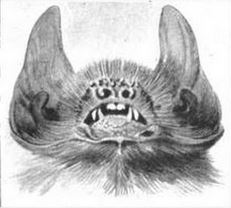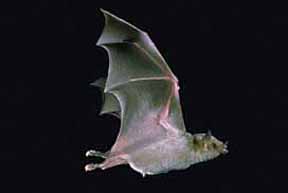
Echolocation, also called bio sonar, is a biological active sonar used by several animal groups, both in the air and underwater. Echolocating animals emit calls and listen to the echoes of those calls that return from various objects near them. They use these echoes to locate and identify the objects. Echolocation is used for navigation, foraging, and hunting prey.

The spectral bat, also called the great false vampire bat, great spectral bat, American false vampire bat or Linnaeus's false vampire bat, is a large, carnivorous leaf-nosed bat found in Mexico, Central America, and South America. It is the only member of the genus Vampyrum; its closest living relative is the big-eared woolly bat. It is the largest bat species in the New World, as well as the largest carnivorous bat: its wingspan is 0.7–1.0 m (2.3–3.3 ft). It has a robust skull and teeth, with which it delivers a powerful bite to kill its prey. Birds are frequent prey items, though it may also consume rodents, insects, and other bats.

The Mexican free-tailed bat or Brazilian free-tailed bat is a medium-sized bat native to North, Central, and South America and the Caribbean, so named because its tail can be almost half its total length and is not attached to its uropatagium. It has been claimed to have the fastest horizontal speed of any animal, reaching top ground speeds over 99 mph (160 km/h). It also flies the highest among bats, at altitudes around 3,300 m (10,800 ft).

The Jamaican, common, or Mexican fruit bat is a frugivorous bat species native to the Neotropics.

The family Mormoopidae contains bats known generally as mustached bats, ghost-faced bats, and naked-backed bats. They are found in the Americas from the Southwestern United States to Southeastern Brazil.

Parnell's mustached bat is an insectivorous bat native to the Americas. It ranges from southern Sonora, Mexico, south to Brazil. It has a wider historical range; fossil specimens have been collected on the island of New Providence in the Bahamas.

The big naked-backed bat, is a bat species from South and Central America.

Davy's (lesser) naked-backed bat is a small, insect-eating, cave-dwelling bat of the Family Mormoopidae. It is found throughout South and Central America, including Trinidad, but not Tobago, Guyana, Suriname, or French Guiana. Specimens of this bat had been found infected with rabies in Trinidad during the height of that island's vampire-bat-transmitted rabies epidemic of the early half of the 20th century, but not in recent times.

The buffy flower bat is a species of bat in the leaf-nosed bat family, Phyllostomidae. It is found in the Bahamas, the Cayman Islands, Cuba, and Jamaica.

Sundevall's roundleaf bat, also called Sundevall's leaf-nosed bat, is a species of bat in the family Hipposideridae.

The greater long-nosed bat or Mexican long-nosed bat is a species of bat in the family Phyllostomidae. It is found in Mexico and the United States. It chiefly consumes pollen and nectar, particularly from agave plants and cacti. Its habitat includes desert scrub and open woodlands, however, it is threatened by habitat loss.

Macleay's mustached bat is a species of bat in the family Mormoopidae. It is found in Cuba and Jamaica, and is threatened by habitat loss. The species is named for William Sharp Macleay, who collected the type specimen.
The sooty mustached bat is a species of bat in the family Mormoopidae. It is found in throughout the Greater Antilles, in Cuba, Hispaniola, Jamaica, and Puerto Rico.
When an echolocating bat approaches a target, its outgoing sounds return as echoes, which are Doppler shifted upward in frequency. In certain species of bats, which produce constant frequency (CF) echolocation calls, the bats compensate for the Doppler shift by changing their call frequency as they change speed towards a target. This keeps the returning echo in the same frequency range as the normal echolocation call. This dynamic frequency modulation is called the Doppler shift compensation (DSC), and was discovered by Hans Schnitzler in 1968.

The Florida bonneted bat or Florida mastiff bat is a species of bat in the genus Eumops, the bonneted bats or mastiff bats. Until recently, it was classified as a subspecies of Wagner's bonneted bat. It is endemic to southern Florida in the United States. This species has one of the smallest geographical distributions of any New World bat. It has been called "one of the most critically endangered mammal species in North America". It is protected under the Endangered Species Act.

The Cuban greater funnel-eared bat is a species of funnel-eared bat. It is endemic to a cave in westernmost Cuba.

The pristine mustached bat is an extinct Late Quaternary species of bat in the endemic Neotropical family Mormoopidae. It was distributed in Cuba and possibly Florida.
The Paraguana moustached bat occurs only on the Paraguaná Peninsula of Venezuela. The entire population uses three caves, one of which is subject to human vandalism. Their total range is less than 400 km2 (150 sq mi). In 2008, the caves where the bat is found were protected by the creation of the Cuevas de Paraguaná Wildlife Sanctuary–the first wildlife sanctuary in Venezuela.

Eumops ferox, the fierce bonneted bat or the chestnut mastiff bat, is a species of free-tailed bat found in the Caribbean and Mexico. Until recently, it was synonymous with Wagner's bonneted bat.


















